Engage NY Eureka Math 7th Grade Module 5 Lesson 3 Answer Key
Eureka Math Grade 7 Module 5 Lesson 3 Example Answer Key
Example 2: Equally Likely Outcomes
The sample space for the paper cup toss was on its side, right side up, and upside down.
The outcomes of an experiment are equally likely to occur when the probability of each outcome is equal.
Toss the paper cup 30 times, and record in a table the results of each toss.
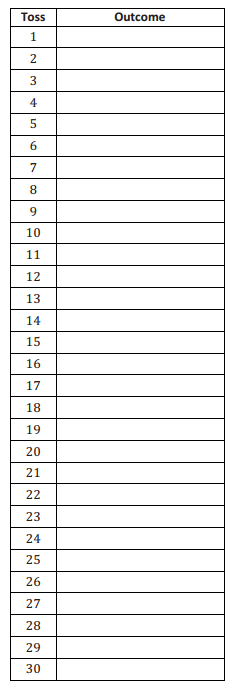
Answer:

Eureka Math Grade 7 Module 5 Lesson 3 Exercise Answer Key
Exercises 1–6
Jamal, a seventh grader, wants to design a game that involves tossing paper cups. Jamal tosses a paper cup five times and records the outcome of each toss. An outcome is the result of a single trial of an experiment.
Here are the results of each toss:

Jamal noted that the paper cup could land in one of three ways: on its side, right side up, or upside down. The collection of these three outcomes is called the sample space of the experiment. The sample space of an experiment is the set of all possible outcomes of that experiment.
For example, the sample space when flipping a coin is heads, tails.
The sample space when drawing a colored cube from a bag that has 3 red, 2 blue, 1 yellow, and 4 green cubes is red, blue, yellow, green.
For each of the following chance experiments, list the sample space (i.e., all the possible outcomes).
Exercise 1.
Drawing a colored cube from a bag with 2 green, 1 red, 10 blue, and 3 black
Answer:
Green, red, blue, black
Exercise 2.
Tossing an empty soup can to see how it lands
Answer:
Right side up, upside down, on its side
Exercise 3.
Shooting a free throw in a basketball game
Answer:
Made shot, missed shot
Exercise 4.
Rolling a number cube with the numbers 1–6 on its faces
Answer:
1, 2, 3, 4, 5, or 6
Exercise 5.
Selecting a letter from the word probability
Answer:
p, r, o, b, a, i, I, t, y
Exercise 6.
Spinning the spinner:
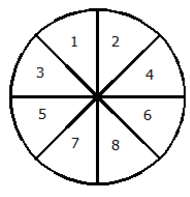
Answer:
1, 2, 3, 4, 5, 6, 7, 8
Exercises 7–12
Exercise 7.
Using the results of your experiment, what is your estimate for the probability of a paper cup landing on its side?
Answer:
Answers will vary. The probability for the sample provided is \(\frac{19}{30}\).
Exercise 8.
Using the results of your experiment, what is your estimate for the probability of a paper cup landing upside down?
Answer:
Answers will vary. The probability for the sample provided is \(\frac{5}{30}\), or \(\frac{1}{6}\).
Exercise 9.
Using the results of your experiment, what is your estimate for the probability of a paper cup landing right side up?
Answer:
Answers will vary. The probability for the sample provided is \(\frac{6}{30}\), or \(\frac{1}{5}\).
Exercise 10.
Based on your results, do you think the three outcomes are equally likely to occur?
Answer:
Answers will vary, but, according to the sample provided, the outcomes are not equally likely.
Exercise 11.
Using the spinner below, answer the following questions.

a. Are the events spinning and landing on 1 or 2 equally likely?
b. Are the events spinning and landing on 2 or 3 equally likely?
c. How many times do you predict the spinner will land on each section after 100 spins?
Answer:
a. Yes. The areas of sections 1 and 2 are equal.
b. No. The areas of sections 2 and 3 are not equal.
c. Based on the areas of the sections, approximately 25 times each for sections 1 and 2 and 50 times for section 3.
Exercise 12.
Draw a spinner that has 3 sections that are equally likely to occur when the spinner is spun. How many times do you think the spinner will land on each section after 100 spins?
Answer:
The three sectors should be equal in area. Expect the spinner to land on each section approximately 33 times (30–35 times).

Eureka Math Grade 7 Module 5 Lesson 3 Problem Set Answer Key
Question 1.
For each of the following chance experiments, list the sample space (all the possible outcomes).
a. Rolling a 4-sided die with the numbers 1–4 on the faces of the die
b. Selecting a letter from the word mathematics
c. Selecting a marble from a bag containing 50 black marbles and 45 orange marbles
d. Selecting a number from the even numbers 2–14, including 2 and 14
e. Spinning the spinner below:
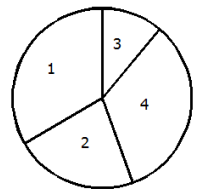
Answer:
a. 1, 2, 3, 4
b. m, a, t, h, e, i, c, s
c. Black, orange
d. 2, 4, 6, 8, 10, 12, 14
e. 1, 2, 3, 4
Question 2.
For each of the following, decide if the two outcomes listed are equally likely to occur. Give a reason for your answer.
a. Rolling a 1 or a 2 when a 6-sided number cube with the numbers 1–6 on the faces of the cube is rolled
b. Selecting the letter a or k from the word take
c. Selecting a black or an orange marble from a bag containing 50 black and 45 orange marbles
d. Selecting a 4 or an 8 from the even numbers 2–14, including 2 and 14
e. Landing on a 1 or a 3 when spinning the spinner below

Answer:
a. Yes. Each has the same chance of occurring.
b. Yes. Each has the same chance of occurring.
c. No. Black has a slightly greater chance of being chosen.
d. Yes. Each has the same chance of being chosen.
e. No. 1 has a larger area, so it has a greater chance of occurring.
Question 3.
Color the squares below so that it would be equally likely to choose a blue or yellow square.
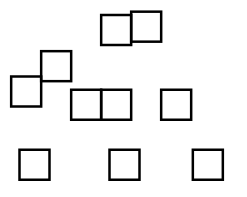
Answer:
Answers will vary, but students should have the same number of squares colored blue as they have colored yellow.
Question 4.
Color the squares below so that it would be more likely to choose a blue than a yellow square.
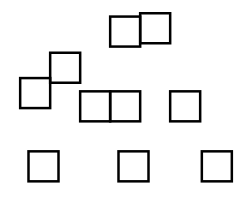
Answer:
Answers will vary. Students should have more squares colored blue than yellow.
Question 5.
You are playing a game using the spinner below. The game requires that you spin the spinner twice. For example, one outcome could be yellow on the 1st spin and red on the 2nd spin. List the sample space (all the possible outcomes) for the two spins.
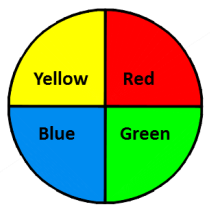
Answer:
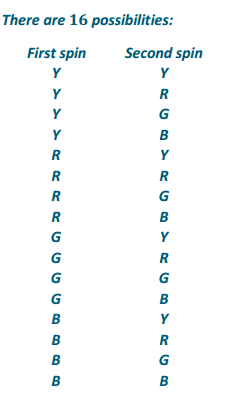
Question 6.
List the sample space for the chance experiment of flipping a coin twice.
Answer:
There are four possibilities:
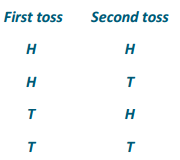
Eureka Math Grade 7 Module 5 Lesson 3 Exit Ticket Answer Key
The numbers 1–10 are written on note cards and placed in a bag. One card will be drawn from the bag at random.
Question 1.
List the sample space for this experiment.
Answer:
1, 2, 3, 4, 5, 6, 7, 8, 9, 10
Question 2.
Are the events selecting an even number and selecting an odd number equally likely? Explain your answer.
Answer:
Yes. Each has the same chance of occurring. There are 5 even and 5 odd numbers in the bag.
Question 3.
Are the events selecting a number divisible by 3 and selecting a number divisible by 5 equally likely? Explain your answer.
Answer:
No. There are 3 numbers divisible by 3 (3, 6, and 9) but only 2 numbers divisible by 5 (5 and 10). So, the chance of selecting a number divisible by 3 is slightly greater than the chance of selecting a number divisible by 5.